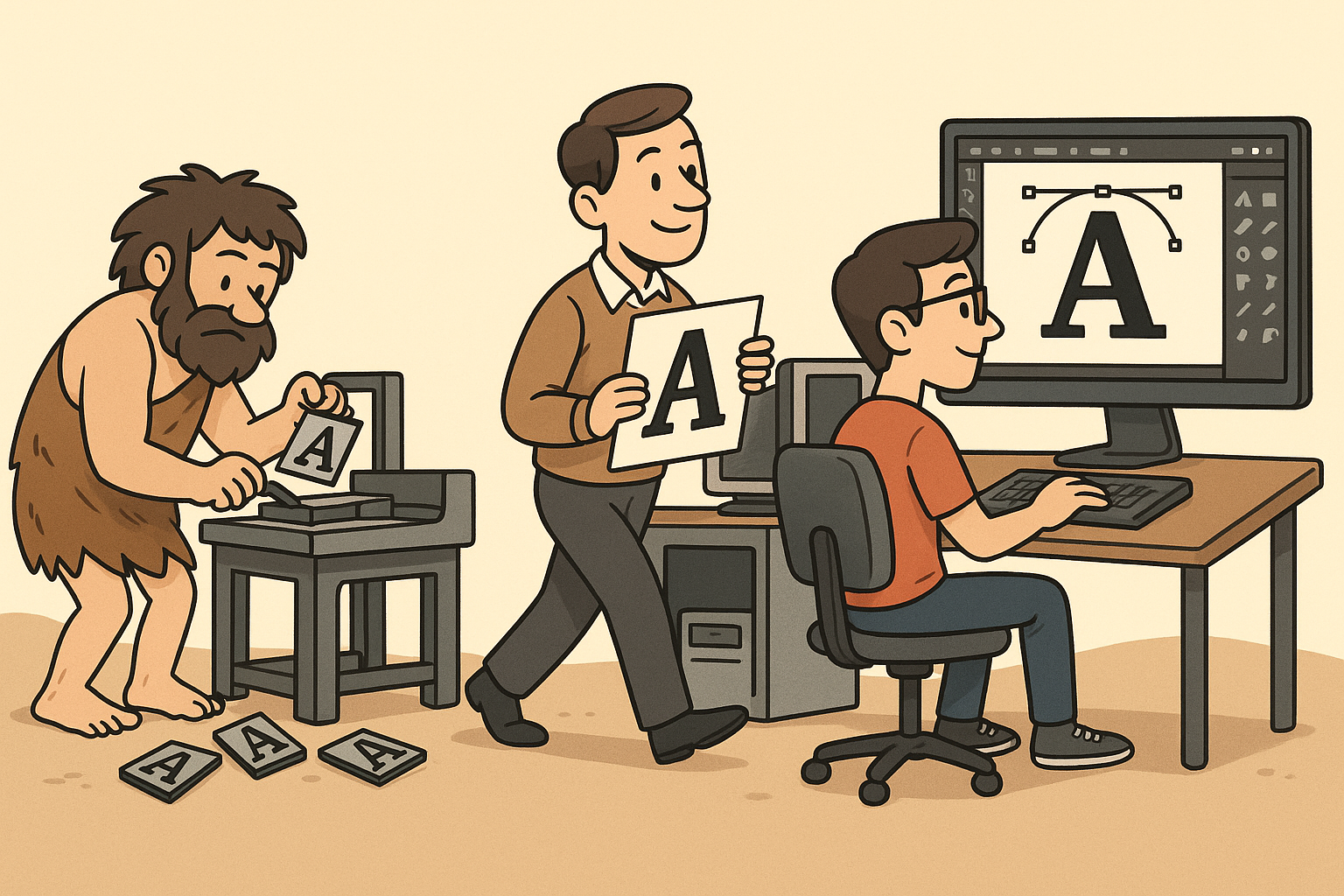Your Cart is Empty
Customer Testimonials
-
"Great customer service. The folks at Novedge were super helpful in navigating a somewhat complicated order including software upgrades and serial numbers in various stages of inactivity. They were friendly and helpful throughout the process.."
Ruben Ruckmark
"Quick & very helpful. We have been using Novedge for years and are very happy with their quick service when we need to make a purchase and excellent support resolving any issues."
Will Woodson
"Scott is the best. He reminds me about subscriptions dates, guides me in the correct direction for updates. He always responds promptly to me. He is literally the reason I continue to work with Novedge and will do so in the future."
Edward Mchugh
"Calvin Lok is “the man”. After my purchase of Sketchup 2021, he called me and provided step-by-step instructions to ease me through difficulties I was having with the setup of my new software."
Mike Borzage
Design Software History: The Evolution of Typography: From Traditional Print to Dynamic Digital Design Software
June 15, 2025 11 min read


The Role of Typography in Early Printed and Digital Media
Historical Context and Early Print Innovations
The history of typography is deeply interwoven with the evolution of human communication, beginning with the early days of printed media and gradually extending into the digital realm. During the early centuries, typography was a craft often reserved for skilled artisans who painstakingly hand-crafted individual characters for printing presses. These early practitioners harnessed the power of movable type to disseminate information, creating a lasting impact on the cultural and intellectual development of societies. As the printing revolution accelerated in the 15th and 16th centuries, the art of type design became an essential element in producing books, pamphlets, and other printed works. The development of sophisticated typefaces enabled the expression of ideas with clarity and elegance. This period witnessed the birth of iconic fonts that still inspire contemporary designers, showcasing early instances of what we now refer to as **typographic design history**.
Transition into Digital Media and its Implications
With the advent of digital technologies, typography experienced a dramatic transformation. Designers moved from physical type blocks and painstaking manual adjustments to the utilization of computer algorithms and digital interfaces that ensured precision and adaptability in font design. The shift to digital fonts unlocked new dimensions of creativity and allowed rapid experimentation, aligning with the rising demands of modern communication. Digital typography not only provided enhanced flexibility in achieving visual effects but also democratized the design process, making it more accessible to a wider range of creators. This evolution laid the groundwork for the sophisticated software-driven design workflows of today, where fonts could be manipulated with ease and precision. The integration of digital typography has consistently impacted how designers think about legibility, brand identity, and cultural expression, serving as a cornerstone for contemporary design software.
The Transition from Traditional Type Design to Digital Fonts
Bridging the Gap Between Analog and Digital Processes
Advancements in digital technologies forced a paradigm shift from traditional, hand-drawn type design to processes that embraced the precision of computer-aided design. In the analog era, type design was deeply rooted in craftsmanship, with detailed attention paid to each individual stroke of the letter. Designers often relied on physical tools such as chisels and ink to create distinct characters that had to be reproduced manually. However, as computing power increased, traditional skills were merged with emergent techniques capable of representing letter forms in a digital format. This hybrid approach provided an opportunity to digitize centuries of expertise and allowed for complex reproductions of detailed letterforms. The transition involved the development of programs and software that could interpret these hand-crafted objects and transform them into scalable digital typefaces, ensuring both historical fidelity and modern usability.
Digital Conversion Techniques and New Opportunities
The transition process was multifaceted and involved numerous technical challenges. Designers and engineers collaborated to create algorithms capable of interpreting analog inputs into scalable vector representations. Among the breakthroughs during this period, techniques such as anti-aliasing and hinting emerged, which were crucial for ensuring legibility across different display resolutions. Furthermore, the introduction of **scalable vector graphics (SVG)** in modern design software allowed for smoother transitions and richer graphic details that had long been a limitation of bitmap fonts. Key elements of this revolution included the following:
- Development of digital imaging and scanning technologies to capture analog details.
- Implementation of vectorization algorithms for reproducible and scalable fonts.
- Incorporation of anti-aliasing techniques to smooth out jagged edges and improve readability.
These advancements not only revolutionized the way typefaces were produced but also led to an explosion of creativity in digital art and design, positioning typography as a cornerstone of contemporary communication and visual storytelling.
Early Challenges and Opportunities in Digital Design Software
Overcoming Technical Barriers in the Digital Era
In the initial stages of the digital revolution, designers and engineers faced significant challenges as they attempted to translate the intricacies of traditional typography into a digital format. The computational power available at the time was limited, and early software struggled with rendering detailed letterforms accurately. Hardware constraints often necessitated compromises in detail and fidelity, resulting in fonts that lacked the nuanced elegance of their analog counterparts. Despite these technological constraints, the digital arena offered unique opportunities. Early design software pioneers explored various data structures and algorithms, seeking optimal ways to store and render fonts with high precision. This period clarified the need for robust digital platforms that could support dynamic typographic systems and paved the way for solutions we now take for granted in modern computing.
Emergence of Specialized Design Tools
During these formative years, a number of innovative approaches and debugging practices were implemented to address the limitations of digitizing type. Developers experimented with discrete pixel mapping and bitmap handling, gradually evolving the capabilities of design software. The challenges included:
- Limited screen resolutions that affected the clarity and artistic integrity of typefaces.
- The necessity for efficient algorithms that could operate within the hardware limitations of early computers.
- Balancing design aesthetics with the functional requirements of digital systems.
Despite these hurdles, this period was marked by an innovative spirit that eventually transformed digital typography into a field rich with creative possibilities. The early challenges not only spurred rapid technological improvements but also inspired a generation of digital typeface designers and engineers. Their persistent refinement of digital type systems laid the groundwork for the expansive possibilities of modern typography and design software.
The Integration of Typography in Pioneering Design Programs
Early Software Innovations and Digital Typography
As the capabilities of computers grew, typography found a natural home within pioneering design programs. Software such as Adobe Illustrator and various early desktop publishing tools began incorporating advanced typographic functionalities, allowing users unprecedented control over letterforms and layout. This innovation was emblematic of the broader shift towards digital media, where the interplay between text, graphics, and layout was meticulously controlled through software interfaces. The integration of typography in these early programs allowed designers not only to experiment with new visual styles but also to create complex compositions that seamlessly merged text with images and other elements. This digital integration fundamentally transformed how typography was used in everything from printed media to digital advertisements, establishing a dynamic interplay between design and technology.
Enhancing Creative Flexibility with Digital Tools
Early adopters of digital design software quickly recognized the potential that lay in the combination of type with graphic elements. Designers could experiment with scaling, rotation, and deformations—capabilities that were virtually impossible under traditional printing constraints. These revolutionary tools provided designers with options such as:
- Layer-based editing that allowed for precise control over typography and background graphics.
- Real-time previews of typographic adjustments within layout compositions.
- Integration of multiple font styles and weights to highlight key messages and branding identities.
By enabling a higher degree of creative flexibility, these software innovations not only transformed the artistic landscape but also set the stage for the modern design interface. The pioneering work in digital typography software ultimately redefined production pipelines and profoundly influenced how design professionals approached the craft of visual communication.
Key Breakthroughs: From Bitmap Fonts to Scalable Vector Fonts
Differentiating Bitmap and Vector-Based Typography
The evolution of digital typography is best exemplified by the transition from bitmap fonts, which relied on pixel-based representations, to scalable vector fonts that utilize mathematical curves to define shape and structure. Bitmap fonts, characterized by their fixed resolution appearance, were initially adequate for the nascent digital displays but proved inefficient when scaling was necessary. Designers soon discovered that the limitations of bitmap representations could lead to jagged edges and less clarity when applied to high-resolution displays. In contrast, scalable vector fonts offered fluidity and precision, as they were based on fundamental geometric principles. These vector fonts could be resized without loss of quality, representing a significant breakthrough in ensuring consistency across various mediums. This advancement brought about a dramatic shift in design philosophy, signifying the move toward more flexible and adaptive typography.
Advancements and Their Impact on Software Capabilities
The shift to vector-based typography not only enhanced visual quality but also influenced the way design software exploited computational resources. Developers integrated advanced rendering algorithms to accommodate the complex mathematical models underlying vector fonts. The benefits of scalable vector fonts were clear and include:
- A notable improvement in legibility and clarity across various display sizes and print resolutions.
- Enhanced flexibility for designers to experiment with intricate designs, effects, and transformations.
- Streamlined workflows that allowed for non-destructive editing and real-time rendering, which ultimately improved user experience.
As these advancements took hold, the digital typography landscape underwent a dramatic transformation, elevating the standard of visual communication and setting the stage for an era of unprecedented innovation in design software development. The process of moving from bitmap to vector fonts has been one of the most significant milestones in achieving the high-fidelity digital experiences that are demanded by modern applications.
Influential Figures and Companies in Shaping Digital Typography
Pioneers and Visionaries in Digital Typography
The story of digital typography is marked by the contributions of numerous visionary individuals and pioneering companies who dedicated themselves to bridging the gap between artistic craftsmanship and technological innovation. Companies like Adobe and Apple played instrumental roles in redefining software approaches to design and typography. Pioneers at these firms developed technologies that ultimately revolutionized how fonts were rendered and manipulated on digital displays. Notable typographic designers collaborated with software engineers to generate tools that captured the nuance of hand-drawn letterforms and translated them into digital environments. This confluence of creative vision and technical expertise has secured a lasting legacy in the digital age. Renowned typographic artists and engineers alike pushed the boundaries of what was possible, ensuring that digital typography not only maintained its artistic integrity but also evolved into a technically robust discipline that influences countless aspects of contemporary design.
Collaboration Between Industry Leaders and Their Impact
The collaborative spirit that characterized this era fostered an environment in which bold ideas could flourish. Key contributions include:
- Development of cutting-edge font editing software that enabled precise modifications at the pixel and vector level.
- Implementation of comprehensive type libraries that served as invaluable resources for designers worldwide.
- A culture of innovation that encouraged continuous refinement of both type aesthetics and rendering technologies.
As influential figures from Adobe, Apple, and other pioneering companies solidified their positions as leaders in digital typography, their work set the benchmark for comprehensive design software that combined beauty with technical excellence. Their innovations have left an indelible mark on the industry, as evidenced by the enduring relevance of their contributions. The legacy of these pioneers is still felt today in every aspect of digital typography, from the intricate design of digital fonts to the robust functionalities of modern design software.
Evolution of Typographic Tools within Contemporary Design Applications
Modern Software and Refined Typographic Functionalities
Contemporary design applications have considerably advanced the tools available for managing and manipulating typography. Today’s software is equipped with features that offer unparalleled precision and creative flexibility. As user interfaces continue to evolve, typographic degrees of freedom are no longer limited to mere static presentation but extend to dynamic interactions that enhance user experience. Tools integrated into programs like Adobe Creative Cloud, Sketch, and Figma have redefined typographical processes by incorporating robust libraries, advanced rendering engines, and intuitive design interfaces. The influence of **digital typography innovation** within these applications is visible across numerous design elements, encompassing user interface design, product visualization, and interactive media.
Key Developments That Shaped Contemporary Experiences
These modern innovations reflect the fusion of art and algorithm as designers leverage technology not only to retain the charm of classical typography but also to push the boundaries of creativity. Significant developments include:
- Real-time dynamic type manipulation, enabling live previews and instantaneous adjustments.
- Integration of cloud-based libraries that allow seamless access to a vast repository of typefaces and design resources.
- Enhanced support for responsive typography, ensuring that text remains legible and aesthetically pleasing across a range of devices and screen sizes.
The current generation of design tools incorporates these innovations, resulting in a digital environment where typography is a living, breathing element of user experiences. By combining intuitive interfaces with powerful algorithmic underpinnings, modern software not only preserves the historical traditions of typography but also expands its potential. This synthesis of legacy and innovation continues to shape the visual landscape of the digital world, influencing everything from mobile app design to sophisticated branding and advertising campaigns.
Impact of Digital Typography on User Interfaces, Branding, and Product Visualization
Transforming Digital Communication
Digital typography has dramatically transformed how brands communicate their identity and how users interact with digital environments. In today’s bustling digital ecosystem, the clarity, expressiveness, and aesthetic appeal of typography are paramount. Companies invest considerable resources into the development of unique typefaces that become central to their brand identity, ensuring that every piece of communication resonates with its intended audience. The evolution of typography in the digital sphere has led to innovative interactions in user interfaces where text is not merely an information carrier but also a dynamic component of the overall user experience. Integrating sophisticated typography into user interface design helps ensure that digital products are accessible, visually harmonious, and instantly recognizable. This evolution highlights the importance of maintaining a strong typographic voice in modern design, seamlessly blending function with artistic expression.
Design Techniques and Strategic Approaches
The use of typography in contemporary design is informed by several strategic factors:
- Employing **brand-specific typefaces** that encapsulate the ethos and personality of the brand.
- Utilizing dynamic and responsive typography to accommodate various user contexts and screen sizes.
- Applying subtle animation and interaction effects that enhance the user's navigational experience without compromising readability.
These techniques ensure that every touchpoint of digital communication—be it a website, mobile app, or interactive kiosk—delivers a cohesive, engaging experience. In an era where design interfaces are increasingly on the cutting edge of technology and usability, typography plays a key role in reinforcing a brand’s narrative while simultaneously contributing to the functional performance of a product. The convergence of branding, usability, and visual storytelling through typography is a testament to its enduring influence in the evolution of digital design.
Mathematical Models and Algorithmic Design in Developing Dynamic Typefaces
The Role of Mathematics in Digital Typography
Behind the scenes of dynamic, responsive typefaces lies a complex network of mathematical models and algorithms that enable precise control over curves, weights, and spacing. The integration of computational methods into type design has given rise to new possibilities that were inconceivable in the pre-digital era. Advanced computational geometry, parametric equations, and spline models have collectively contributed to the evolution of digital typefaces. As designers craft new letterforms, algorithms help ensure that every curve flows naturally and that each transition between strokes maintains visual harmony. This intricate blend of art and science has allowed for the creation of highly adaptable type systems that can respond dynamically to various constraints, offering a level of customizability unparalleled in traditional typography.
Algorithmic Innovations in Typography
Cutting-edge design software now incorporates a range of algorithmic solutions that enhance both the aesthetics and functionality of type. These innovations include:
- The use of procedural generation techniques to create variations of typefaces that adapt to different contexts.
- Automated kerning and glyph adjustment algorithms that ensure consistent letter-spacing across a variety of fonts and styles.
- Integration of advanced mathematical models, including Bézier curves and spline interpolation, to create smooth and precise curves in digital letterforms.
The contribution of these mathematical and algorithmic techniques has been transformative. Modern software engineers and type designers now work collaboratively to refine these models, ensuring that each digital typeface can exhibit both flexibility and consistency. This union of design intuition and rigorous computational methods not only enhances efficiency but also paves the way for future innovations that promise to redefine how typography is conceptualized and applied in the digital space.
Conclusion: Recap, Reflection, and Final Thoughts
Recapping the Journey of Digital Typography
The evolution of digital typography stands as a compelling narrative of innovation, adaptation, and creativity that spans centuries. From its humble beginnings in early printed media to the sophisticated digital systems of today, typography has continuously adapted to reflect the changing needs of society. Early challenges surrounding the translation of tangible type to digital form have given way to a realm where mathematical precision meets expressive design. Influential companies and visionary pioneers such as Adobe and Apple played significant roles in nurturing this evolution, ensuring that typography remained at the heart of effective visual communication. The integration of dynamic algorithms, scalable vector technology, and responsive design philosophies has fostered an environment where typography is not only a tool for readability but also an integral aspect of overall design aesthetics.
Future Perspectives and Enduring Impact
As we consider the future, it is clear that the innovations made in digital typography will continue to influence emerging trends in user interface design, branding, and product visualization. The effective combination of artistic craftsmanship with rigorous computational methods represents a paradigm that promises even greater adaptability and creative expression in the years to come. The work undertaken by early pioneers has provided a robust foundation, allowing designers today to experiment and push the boundaries of what digital typography can achieve. Looking forward, designers and software developers alike are poised to explore new territories where dynamic type adapts seamlessly to an ever-expanding array of digital contexts, ensuring that typography remains an enduring, vital component of design. The legacy of digital typography is one of constant evolution—a journey that, while rooted in historical practices, continues to inspire and shape the future of design software.
Also in Design News

Cinema 4D Tip: Lock Framing Early with Cinema 4D Safe Frames and Aspect Overlays
October 30, 2025 2 min read
Read More
ZBrush Tip: Conservative Projection Workflow for Artifact-Free Detail Transfer
October 30, 2025 2 min read
Read More
V-Ray Tip: Bake Static GI into Lightmaps for Real-Time Engines
October 30, 2025 2 min read
Read MoreSubscribe
Sign up to get the latest on sales, new releases and more …


